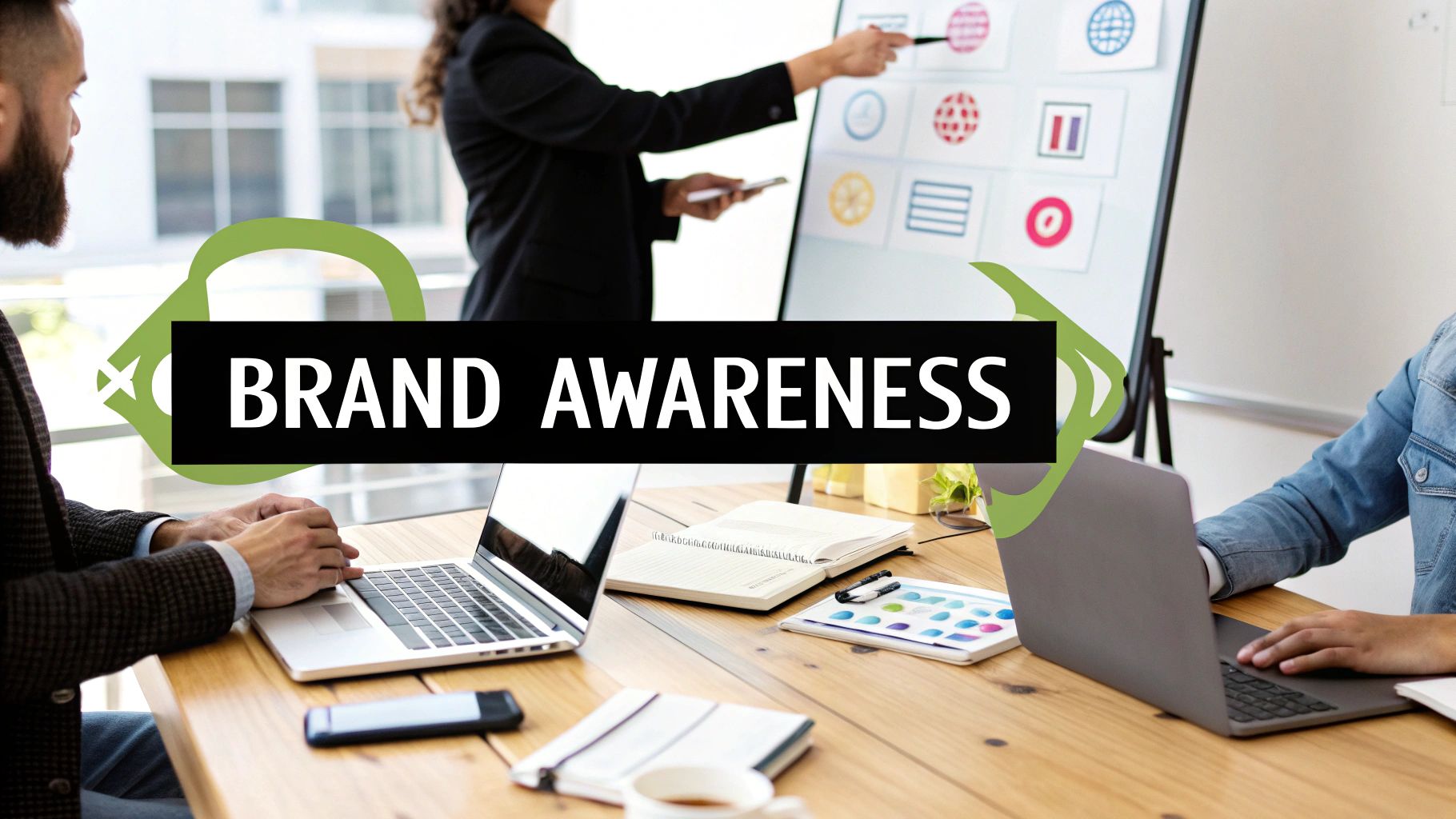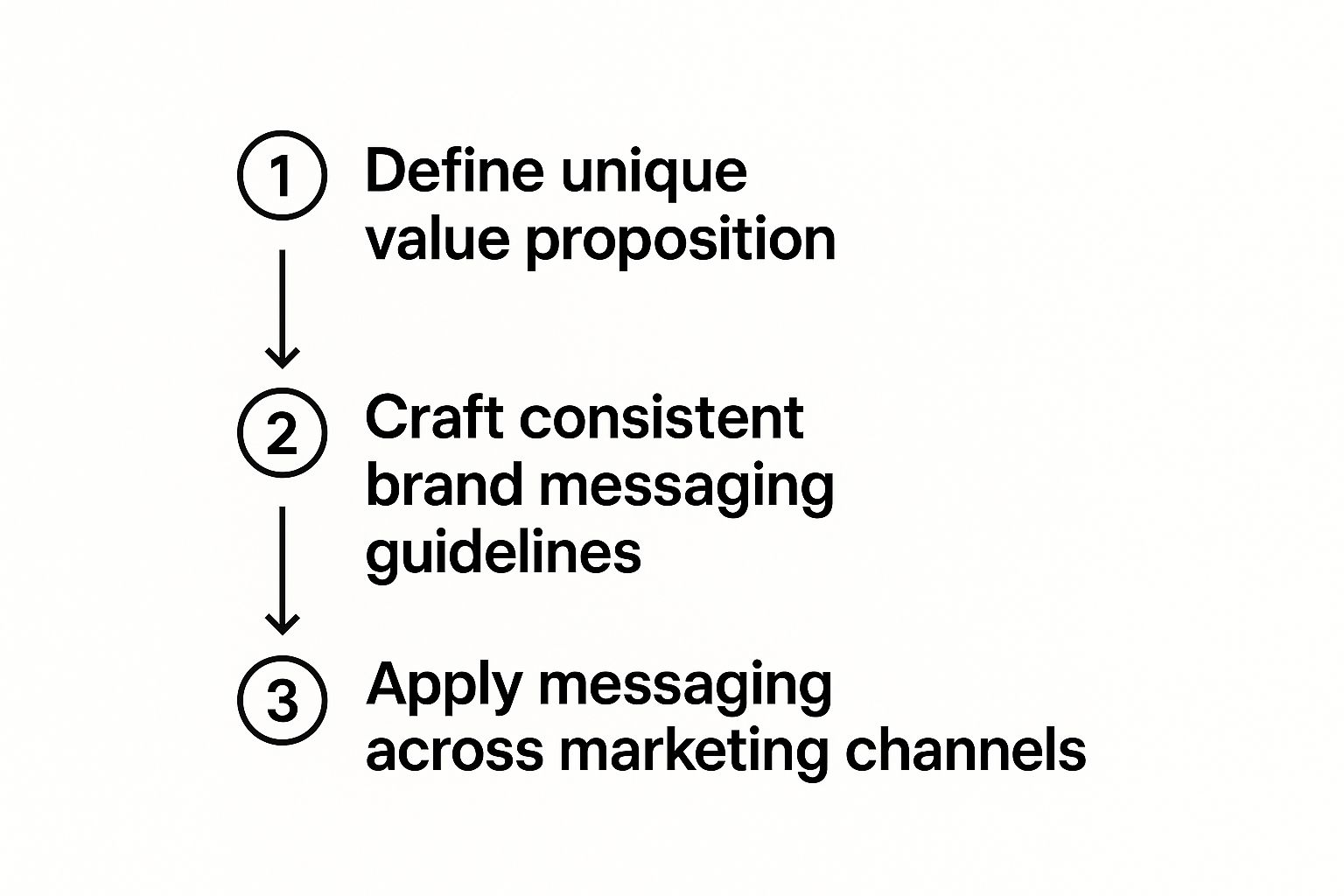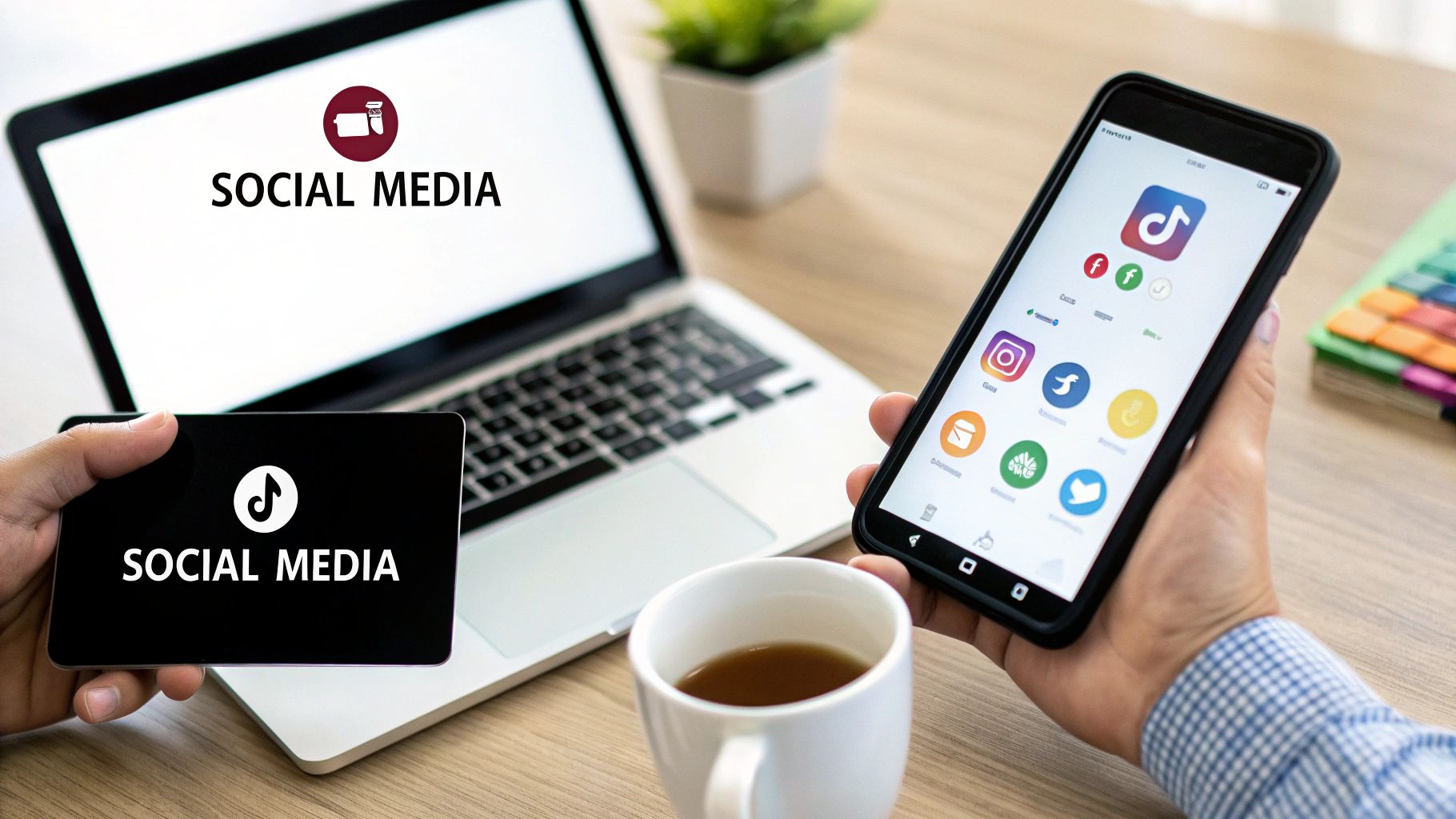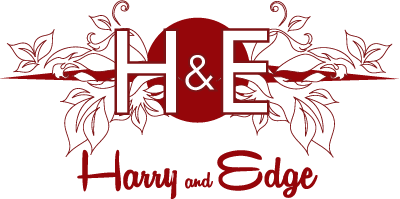Let's be honest, "brand awareness" sounds a bit like marketing jargon, doesn't it? But really, it’s about making your company the first thing people think of when they need what you sell. It’s about getting your brand's story so firmly stuck in their heads that you become their go-to, like how people say "Hoover" for any vacuum cleaner.
This isn't just about plastering your logo everywhere. It's done with smart, consistent messaging and by showing up in the right places, with a unique identity that people actually remember.
Building Your Unforgettable Brand Identity

Before you can start shouting about your brand from the rooftops, you’ve got to figure out what you’re actually going to say. This is the bedrock of everything that follows. Think of it as defining your brand's DNA—its personality, its voice, its mission, and the core message that will guide every single marketing decision you make from here on out.
It's basically character development for your business. Is your brand witty and a bit of a rebel, or is it more like a comforting, trustworthy friend? Whatever you decide, it has to be consistent everywhere. A brilliant example is what Ryan Reynolds did with Aviation Gin. He didn’t just slap his name on the bottle; he injected his signature sharp, self-aware humour into the brand's very soul. Suddenly, a traditional spirit had a magnetic personality that sliced through a ridiculously crowded market.
Define Your Core Mission and Values
Your mission is your "why." It's the real reason your company exists, beyond just making a profit. A clear, compelling mission doesn’t just give your team a North Star; it gives customers a reason to connect with you on a much deeper level.
Once you’ve nailed your mission, your values are the principles that guide how you act. These aren't just fluffy words to stick on a poster in the break room. They should genuinely influence everything, from how you develop your products to the way you handle a customer complaint like a pro.
- Mission: What’s the fundamental purpose of your business?
- Vision: Where do you want this brand to be in the future?
- Values: What are the core beliefs that drive how you do things?
A brand is no longer what we tell the consumer it is—it is what consumers tell each other it is. Defining your identity gives you a powerful story for them to share, just like how Oprah Winfrey built a media empire on trust and authenticity.
Understand Your Audience Deeply
You can't get on anyone's radar if you don't know who you're trying to reach. Seriously, a deep understanding of your target audience is non-negotiable. You need to go way beyond basic demographics and get into their heads.
What are their interests, lifestyles, and challenges? What do they actually care about? Where do they hang out online? What makes them laugh? This is the insight that lets you craft a message that genuinely lands. The more you know your audience, the better you can tailor your corporate branding efforts to hit the mark.
Getting this right has a massive impact. In the UK, the top 75 brands saw their collective value grow by a hefty 8%, bouncing back after a few flat years. While old guards like Vodafone are still at the top, the explosive growth of digital-first companies like Revolut (up an insane +479%) proves how a clear, modern brand identity can build awareness and value at lightning speed. You can dig into more of these trends over on Kantar.com.
Designing Your Brand’s Visual Signature
How do you make your brand instantly recognisable in a crowded market? The secret lies in a killer visual signature. This isn’t just about having a nice logo; it's about building a complete visual language that sparks an immediate, gut-level connection with your audience. Think of it as visual shorthand – the thing that tells your story in a split second, long before anyone has read a single word.
Just look at what Rihanna did with Fenty Beauty. She didn't just launch another makeup line; she launched a visual movement. The brand’s bold, clean, and fiercely inclusive imagery, paired with minimalist packaging, instantly screamed modern, accessible luxury. The visuals alone told a powerful story of diversity and confidence, forging a subconscious link with the people she wanted to reach. That's the goal: a look that is unmistakably you.
Crafting Your Visual Language
Your brand's visual language is a cocktail of different ingredients that all need to mix perfectly. When these elements are consistent, they build the kind of familiarity and trust that are the bedrock of brand awareness.
-
Colour Psychology: Your colour palette is more than just a pretty face. Colours stir up deep-seated emotions. Are you all about high energy and boldness (think fiery reds and oranges)? Or are you more calm and dependable (cool blues and deep greens)? Choose wisely.
-
Typography: The fonts you pick say a ton about your brand's personality. A sleek, modern sans-serif font gives off a totally different vibe than a classic, elegant serif. It’s the difference between a tech start-up and a heritage tailor.
-
Imagery Style: What kind of world does your brand live in? Is it filled with sharp, professional product shots, candid lifestyle photos of people having a laugh, or maybe quirky, playful illustrations? This decision sets the entire scene.
Your visual identity is your brand's uniform. It makes sure that no matter where people see you—a social media post, your product packaging, or a pop-up event—they know it’s you in a heartbeat.
The Power of Visual Consistency
Consistency is what separates a decent design from an unforgettable brand. To get there, you need a comprehensive style guide. This is your brand's bible. It lays down the law on exactly how your logo can be used, which colours are your go-tos, and what your photography should always look and feel like. This way, every single touchpoint sings from the same hymn sheet.
This consistent approach is a direct line to building trust, which is absolutely critical for brand recognition. The numbers don't lie: a whopping 55% of first impressions are purely visual. What's more, 81% of consumers say they need to trust a brand before they'll even think about buying from it.
When you bring together a trustworthy, visually coherent image with a strong, visible leadership team—something 65% of consumers look for—you’ve got a potent recipe for loyalty. To see just how intertwined visuals and trust really are, you can review key branding statistics here. This unified approach is how you turn a fleeting glance into a lasting impression.
Alright, you’ve nailed down your brand identity and your look is killer. Now for the fun part: unleashing it on the world. It’s time to find where your people hang out online and start a real conversation. This isn't about shouting into the void; it’s about becoming part of the community.
Just look at how Dwayne 'The Rock' Johnson handles his social media. He’s not just endlessly plugging his latest movie or tequila. He's sharing his insane workouts, his legendary cheat meals, and his thoughts on life. It’s that real, consistent vibe that turns casual followers into a die-hard tribe, making his brand an absolute juggernaut.
Give Them Something to Talk About on Social Media
If you want people to spread the word, you’ve got to create content they can't help but share. The secret sauce is making stuff that’s so useful, entertaining, or just plain cool that hitting the 'share' button is a no-brainer. That's how brand awareness catches fire all on its own.
Think beyond the 'like'. Dive into behind-the-scenes content, show off photos from your customers, or run interactive polls and quizzes. Every single share is like a personal recommendation, and that's marketing gold.
This whole process really hinges on having a clear message that you can hammer home, no matter where you're posting.

As you can see, if your core message is fuzzy, your efforts across different channels will just feel disjointed and won't build any real momentum.
Become the Go-To Expert with Killer Content
Social media is fantastic, but content marketing is how you really plant your flag and become a leading voice in your field. We're talking about creating genuinely helpful blog posts, videos, and guides that not only prove you know your stuff but also get you noticed by search engines.
When someone in your industry is looking for an answer, you want to be the one providing it. A catering company, for example, could write a blog on "10 Wedding Food Ideas That Aren't Boring" or film a video on "How to Plan the Perfect Corporate Buffet." You’re not just selling; you’re solving problems for people who are actively looking for what you offer.
A brilliant content marketing strategy isn’t about the hard sell. It’s about educating and empowering your audience. That’s how you build the kind of trust that turns a casual browser into a loyal fan.
Here in the UK, social media is an absolute beast. Instagram alone has 33.4 million users—that’s nearly half the country! It’s a massive playground for brands, and it's also where influencer marketing has exploded, with ad spending projected to hit a whopping £1.04 billion. But people are savvy. With 97% of UK social users being wary of online mischief, the key is to work with creators who genuinely love your brand. It’s about authentic partnership, not just a paid-for post.
If you’re ready to dive deeper and really nail your online presence, check out these expert social media marketing strategies. And for a seriously fun way to get your brand shared, think about how a social booth at your next event could turn guests into your best marketers.
Digital Awareness Channel Comparison
Choosing the right digital channel is half the battle. Each platform has its own unique flavour and audience. Here’s a quick breakdown to help you pick your playground, complete with examples from celebs who are absolutely smashing it.
| Channel | Best For | Content Type | Celebrity Example |
|---|---|---|---|
| Visual Storytelling & Lifestyle Brands | High-quality photos, Reels, Stories, User-Generated Content | Cristiano Ronaldo: A masterclass in blending personal life, athletic prowess, and brand partnerships to a massive global audience. | |
| TikTok | Trends, Entertainment & Reaching a Younger Audience | Short-form videos, challenges, tutorials, behind-the-scenes clips | Charli D'Amelio: Rose to fame through viral dance trends, showcasing the platform's power to create stars from scratch. |
| B2B, Professional Networking & Industry Leadership | Articles, case studies, company news, professional insights | Richard Branson: Uses the platform to share business advice, company culture insights, and personal reflections on entrepreneurship. | |
| X (Twitter) | Real-time Updates, News & Customer Service | Short text updates, polls, threads, quick video clips | Elon Musk: Drives massive conversations (and controversy) with a mix of memes, company announcements, and direct user engagement. |
Ultimately, the best channels are the ones where your audience is already active and where your brand's personality can truly shine. Don't feel you have to be everywhere at once—pick a couple, do them brilliantly, and expand from there.
Forging Powerful Brand Partnerships

Let's be honest: trying to build a brand all by yourself is like shouting into the wind. It's exhausting, and you rarely get the results you're after. That’s where strategic partnerships come in. Think of them as your secret weapon, a way to tap into new worlds and get your name in front of people who are ready to love what you do.
This isn’t about just sticking your logo on someone else’s stuff. It’s about creating a combined force that makes people stop and pay attention.
The all-time classic? Michael Jordan and Nike. That wasn't just another shoe deal; it was a cultural explosion. Nike wasn't just selling trainers; they were selling the dream of becoming "Like Mike". The collaboration completely changed the game, blurring the lines between sport, fashion, and culture in a way that no ad campaign could ever replicate.
Finding Your Perfect Partner
The best partner isn't always the biggest name you can find. It’s the one that just makes sense. A truly great collaboration feels like it was always meant to be, not something cooked up in a boardroom. You need to look for brands or people who share your values, your vibe, and—most importantly—your audience.
- Value Alignment: Does your potential partner's mission actually click with yours? A mismatch here feels clunky and can leave customers feeling confused.
- Audience Overlap: Are they talking to the same people you want to reach? You're looking for that sweet spot where you can get in front of a new, but still highly relevant, crowd.
- Authentic Connection: Does the partnership tell a compelling story? Taylor Swift teaming up with a guitar company? Makes total sense. Taylor Swift promoting a brand of motor oil? It would raise a few eyebrows.
Finding these potential partners means keeping your radar on at all times. It could be a beloved local business, a B2B company in a complementary field, or an influencer whose personality is a perfect match for your brand.
A brand partnership should be a win-win-win. A win for you, a win for your partner, and a massive win for the audience who gets to experience something genuinely cool and new.
Structuring Deals That Actually Work
Once you've found your ideal match, it's time to put together a deal where everyone feels they’ve hit the jackpot. And it's not always about the money. Think about what you can offer beyond just writing a cheque.
Could you provide your product for their next big event? Can you offer a shout-out to your social media followers or a feature in your email newsletter? Creating a deal that benefits both sides is the bedrock of a long and fruitful partnership. Just look at Ed Sheeran’s collaboration with Heinz—his genuine, lifelong love for their ketchup made the whole thing feel fun, real, and completely authentic.
Great partnerships are built on clarity. Be crystal clear about expectations, what each side will deliver, and how you’ll both measure success. Whether it's tracking referral traffic from their site, a spike in social media mentions, or a direct lift in sales, having defined goals keeps everyone on the same page. This is exactly how to create brand awareness that sticks.
Creating Memorable Offline Experiences
In a world of endless scrolling, a real-life interaction can be the jolt that makes your brand unforgettable. Taking your brand offline isn't about ditching digital; it's about creating tangible moments that people will rush to share online.
This is where the magic happens. You get to turn passive followers into passionate advocates who've actually felt your brand's energy in person.
The power of an immersive event is huge. Just look at how Gwyneth Paltrow scaled Goop from a simple newsletter into a wellness empire. Her "In Goop Health" summits aren't just conferences; they're high-touch, real-world experiences where attendees live the brand's philosophy for a day. That creates a powerful, personal connection that a website click just can't match.
Launching Pop-Ups and Guerilla Stunts
Don't worry, you don't need a Goop-sized budget to make a massive impact. Pop-up shops and guerrilla marketing stunts are brilliant for generating buzz simply by showing up where people least expect you.
The key is to create something so visually interesting or downright fun that people have to take a picture.
Think about designing an "Instagrammable moment"—a beautifully crafted photo wall, a quirky installation, or an interactive display. The goal is simple: give people a cool story to tell their friends, with your brand right at the centre of it.
If you want to go deeper on this, you can learn more about what is experiential marketing and how it forges those lasting connections.
The real magic of offline events is turning your brand into a destination. When you give people a unique experience, they don’t just remember your product; they remember how you made them feel.
Sponsoring and Participating in Community Events
Getting involved in your community is another fantastic way to build that crucial local brand awareness. Sponsoring a local fun run, setting up a booth at a neighbourhood festival, or hosting a free workshop lets you connect with people on their own turf.
These aren't just marketing tactics; they show that your brand is more than just a business. It’s a part of the community's fabric. That builds a level of trust and goodwill that online ads simply can't buy.
- Host a Workshop: Got a skill? Share it. Teach something related to your industry and provide genuine value.
- Sponsor a Local Team: Getting your name on the jerseys of a local sports team is a classic for a reason—it shows you’re a real supporter.
- Partner with a Charity: Align your brand with a cause that reflects your values. Think of how Leonardo DiCaprio uses his fame to champion environmental causes—it feels authentic because it is.
Every handshake, shared laugh, or helpful tip at an offline event builds a more human connection. These are the moments that truly cement your brand in people's minds, giving them a personal reason to choose you when it matters most.
Got Questions About Brand Awareness? Let’s Clear Things Up.

As you start getting serious about making your brand a household name, you’re bound to have a few questions swirling around. It happens to everyone. Let's tackle some of the big ones head-on so you can keep moving forward with confidence.
How Much Should I Actually Budget for This?
Ah, the million-dollar question. Except it doesn't have to be. There’s no single price tag for brand awareness; it’s all about your industry, your ambition, and where you're starting from.
A local coffee shop might smash its goals with a few hundred quid a month on hyper-local social ads. On the other hand, a fintech startup trying to crack the national market could be looking at a five-figure budget straight out of the gate.
My advice? Start smart, not huge. A good rule of thumb is to earmark around 10-20% of your total marketing spend for pure awareness. Dip your toes in a few different channels, see what gets people talking, and then double down on what works.
How Long Until People Actually Know Who We Are?
Building brand awareness is definitely a marathon, not a sprint. Sure, a viral video might give you a fleeting moment in the spotlight, but real, lasting recognition takes time and consistency. It’s about being there, day in and day out.
You should start seeing some green shoots—like a jump in website traffic or a steady climb in social followers—within the first 1-3 months of a focused campaign. But to become that go-to name people think of first? You're playing the long game. Give it a solid six to twelve months of consistent effort.
Think of brand awareness as building a friendship with your audience. It doesn't happen overnight. It requires showing up consistently, providing value, and creating positive experiences time and time again.
Do I Need a Celebrity Endorsement to Succeed?
Absolutely not. Look, having George Clooney sip your coffee (hello, Nespresso) is a phenomenal shortcut, but it’s not the only way—and for most of us, it’s not a realistic one.
The modern playbook has a much more accessible and, frankly, more authentic alternative: micro-influencers.
Partnering with creators in your niche who have smaller but fiercely loyal followings can be a game-changer. It’s more affordable and often builds a deeper, more genuine connection. Focus on building real relationships, encouraging your customers to share their own experiences, and creating a community. That kind of grassroots loyalty is something a fleeting celebrity ad just can't buy. If you want to dive deeper into this, check out these proven strategies to build brand awareness.
Ready to create an unforgettable offline experience that gets everyone talking? Harry and Edge specialises in cutting-edge interactive event hire, from 360° photo booths to digital graffiti walls, designed to make your brand the star of the show. https://www.harryandedge.co.uk
